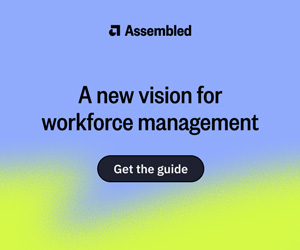Contact centres are often associated with high rates of attrition, so we look into what is causing this and how attrition can be reduced.
1. Make Changes to Improve the Working Atmosphere
If your workplace doesn’t offer some sort of innovative reward scheme or hold social events, it’s unlikely to be a fun place to work. Over time, you will likely lose advisors because of this.
While it may sometimes feel like a superfluous thing, having fun is important and should be organised to a certain extent, before getting advisors to take over bit by bit, so they are more invested in the fun.
Dan Moross, Director of Customer Experience at MOO, adds: “We love to bring in motivational games – like buzzword bingo and guess who, made with avatars of our advisors – to keep our contact centre spirits high, particularly during really busy periods.”

MOO love to use motivational games to keep contact centre spirits high, particularly during really busy periods.
“All of these games have rewards, like an hour to play pool or ping pong, which help to extend the fun, which is great to keep ‘topped-up’ with plenty of food and drink.”
“We have a big ice cream fridge in all of our kitchens, meaning that free ice cream is on tap and we also have a really nice coffee shop, for which we give people free coffee vouchers.”
Also, at MOO’s contact centre, every Friday there’s a free lunch in their kitchen and everyone from the company eats together as a community, to build a good atmosphere. They also have a social events calendar, which is put together by advisors for this purpose.
2. Create Shift Patterns That Suit Advisor Lifestyles
It’s an essential goal of almost any employee across any industry to achieve a good work–life balance, but some contact centres design shift patterns that go against this.
Some shift patterns have higher attrition rates than others, and if your staff are having to work on rotational shifts, where their shift patterns change every week, attrition will be high because nobody has a lifestyle like that.
As Dougie Cameron, Director of addzest consulting, says in our article “How to Avoid Schedule Dissatisfaction“: “Don’t design shifts for efficiency, design shifts so that people want to work them and then calculate the efficiency part afterwards.”

Dougie Cameron
Once you have designed these shifts, it comes down to hiring the right people to work them and to do this well, you should be targeting small groups of people who have reasons for wanting to work a fixed night shift or a fixed Saturday evening shift. But most contact centres take a very different approach.
Dougie explains: “In many contact centres, there is a term that’s used called ‘volume recruitment’ and that is an expression that I think is wrong because it basically says that you have this whole homogeneous bunch of people. But, if you’re recruiting well, you’re trying to talk to small segments of people – otherwise attrition will be high.”
We spoke with Dougie about this topic in much more depth as part of our article: How to Calculate Attrition Rate
3. Set Realistic Expectations for New Recruits
Hiring the right people is important, but so is making sure that you set realistic expectations. If you promise people the moon before they start and then they don’t get it, it’s unlikely that they’re going to feel engaged and motivated to work for you.
Dan Moross adds: “It’s quite common for people to be hired in the contact centre with the potential of getting their foot in the door of a ‘cool’ company – like MOO – but having a desire to work in other departments.”
It’s quite common for people to be hired in the contact centre with the potential of getting their foot in the doorof a ‘cool’ company – like MOO – but having a desire to work in other departments.
Dan Moross
“While we do our best to steer people into these departments over time, it not always possible to do this for everyone. So, making sure that everyone knows that they’re going to have to spend a certain amount of time in the contact centre before they have access to those opportunities, and that they understand what their role is going to be before they start, is really important.”
To help potential advisors better understand the role they are considering signing up for, it can be good to hold open recruitment days instead of traditional one-to-one interviews.
Over the course of the day, you can introduce recruits to their potential work environment and hold open Q&A sessions with the current team – so they can get a real feel for the role. While this may increase in-recruitment attrition, it will lower in-the-job attrition, helping to save resources.
4. Guard Against Advisor Burnout
There are still a number of contact centres that focus on making advisor occupancy as high as possible, seeing it as a good measure for productivity. Not only is this incorrect but it can lead to advisor burnout and that will no doubt lead to increased levels of absenteeism and attrition.
Occupancy is the percentage of time an advisor is on the phone while present on the contact centre floor. It is the manager’s responsibility and not the advisor’s.
Martin Jukes
As Martin Jukes, the Managing Director at Mpathy Plus, says: “Productivity is all about what advisors produce in the time that they are on the phone with a customer, so this is very much in the advisor’s control. But occupancy is the percentage of time an advisor is on the phone while present on the contact centre floor. It is the manager’s responsibility and not the advisor’s.”
Occupancy is therefore a measure of how well you utilise your people and you should target a percentage occupancy when making staffing calculations. This target occupancy should not exceed 85%.
If your occupancy is higher than 85%, advisors will not have the necessary break between calls, causing burnout, which is known to create stress-related problems. Unsurprisingly, these problems are not good for your attrition rates.
Find out the ideal way to measure productivity in our article: How to Calculate Productivity in the Contact Centre
5. Provide Opportunities for Progression
Being a customer service advisor can be a stopgap or a foot in the door for a lot of people, as many won’t see themselves as having a long-term future in the contact centre. So, in order to retain your advisors, it’s important to provide them with a progression pathway.
As Dan Moross says: “Providing the right framework or a model can really help people to understand where they are in their career, what capabilities they have acquired within their current role and which of these capabilities are shared by other careers within the organisation.”
These development conversations will ideally be part of weekly one-to-ones, as is the case at MOO, where advisors can express their future goals and work with the team leader in order to make them successful.

Secondment placements helps advisors to understand what is encompassed in other roles within the company, to see if it’s the right role for them.
Dan continues: “At MOO, we also do a lot of secondments, meaning that we make sure that there’s a possibility for someone to spend time in another part of the organisation. This helps them to understand what is involved in other roles within the company, to see if it’s the right role for them.”
But just remember, not every progression has to be a promotion. It’s also about developing each individual employee to take on more responsibilities, learn more capabilities and skills.
6. Recognise Good Work
It’s important that advisors feel as though what they are doing is important, so you need to show them that you value each contact and give recognition when it is deserved. This includes both little thank-yous and rewards,

Dan Moross
Dan Moross says: “At MOO, we’ve got many different levels of how people are rewarded, which is all tied closely to quality and behavioural things. These behavioural things are hard to measure, so we’ve adopted a scheme where advisors can nominate other members of the teams for particular behaviours that have helped improve the customer’s experience or improved the working environment.”
“Our prizes range from prize draws – including our very own ‘wheel of wow’ – or an extra half an hour at lunch, to a week at our US office, completely paid for by MOO. Those in our US office can also come to our UK office, which is especially great as many of them have never left their home country before.”
Gamifying such recognition processes can certainly promote the right kind of behaviours. If you use performance management tools, they can help you to monitor what’s important to your organisation and clearly and transparently show why certain people are being rewarded.
7. Build Advisor Empowerment and Trust
If you have advisors that you don’t trust or who perceive a lack of trust, that’s going to quickly erode employee motivation and that is a symptom of an adherence-based culture.
Adherence-based cultures are often found in companies that directly target advisors on metrics such as Average Handling Time (AHT) and ask them to follow rigid scripts. It is likely that these contact centres have much higher attrition rates than the contact centre average.
As Dan Moross says: “If your team don’t feel trusted and empowered to do their job and you are mandating how to deal with every interaction by rote, then they are certainly not going to feel motivated before each call.”
If your team don’t feel trusted and empowered to do their job and you are mandating how to deal with every interaction by rote, then they are certainly not going to feel motivated before each call.
Dan Moross
“At MOO, we’ve never had scripts; instead we have overarching guidelines to guide what we want the resolution for our customers to be and arm our advisors with all of the tools and coaching needed to deliver that happiness.”
Instead of scripts providing the solution, advisors are much more empowered when they are supported by their colleagues to make their own informed decisions of what’s best for the customer – which helps to limit attrition and enables a more personalised solution.
For more on empowering your team, read our article: It’s Not Empowerment Unless You Trust People
8. Offer Work Variation
The role of a contact centre advisor can be monotonous, especially if advisors stay on one channel and are constantly answering the same contact types.
While we understand why contact centres may choose to do this, so advisors can keep a strong focus on the customer without having to constantly switch between tasks, it may cause advisors to feel like everyday is “groundhog day”. This will no doubt negatively impact their happiness in the role.
Work with more variety is more engaging for advisors, so if you choose not to multiskill advisors and blend systems, you need to look into other ways of offering variation.
Remember that work with more variety is more engaging for advisors, so if you choose not to multiskill advisors and blend systems, you need to look into other ways of offering variation.
Sky’s contact centre in Stockport does this well, by including a skills matrix in their employee questionnaires, where advisors are asked to make a note of their hobbies that could potentially be put to use in the contact centre.
Once the contact centre knew these hobbies they came up with tasks for them to do, which aided the contact centre and engaged advisors with their passions. Advisors who like art could redesign the contact centre walls, writers could contribute to monthly “buddy books” and other creative members of the team could put together informative videos.
9. Provide Sufficient Support When Handling Customer Queries
While it’s great to empower advisors, they still need guidance to best serve customers, including having the right tools and information made readily available to them. Advisors that feel unsupported will likely be demotivated and more willing to leave.
Martin Jukes says: “The number-one complaint that advisors feedback to us is they get frustrated with their inability to deal with customer queries. So, it may well be that they don’t have the tools to do their job or they haven’t been given the appropriate training to properly service the customer.”
“A similar demotivator for advisors is having inefficient processes, which might be the overall business process or it might be the process for them accessing the best possible information. All of this, as well as poorly performing systems, equates to a lack of advisor support.”

A demotivator for advisors is having inefficient processes, which might be the overall business process or the processes for accessing the best possible information.
One way to better support advisors is to make time in your diary to walk around the contact centre and start off-the-cuff conversations. Get to know them and how they feel like they could be better supported. If you hit upon something that an advisor speaks passionately about or any constantly repeated topics, you know you’ve hit upon something.
Once you have this feedback, let the advisors know what you are doing, again through these conversations, to solve the issue and improve the support that you offer them.
For more important things that you should be talking about with your team, read our article: 10 Great Conversations to Have With Your Team
10. Communicate Well With the Team
Advisors are really important in terms of service improvement because it is they who have the most experience in what is actually going on and how it impacts them. So, it’s very important to listen and communicate with them, as Martin Jukes tells us.
However, Martin also says: “Advisors have told me frequently that they’re not being listened to and that when they raise issues, they’re just ignored.”

Martin Jukes
Ignoring advisors by not listening or providing feedback to them will only cause frustration, and a frustrated team is likely to have a higher churn rate than a happy team who feel listened to.
Martin adds: “Advisors want to come into work and do a good job and it’s important that they know if they’re doing a good job or not. Whether it’s good or bad, it’s important that advisors know what is expected of them, otherwise their work loses meaning and demotivates them.”
To better listen to advisors, you could start focus groups and then implement a “you said, we did” scheme. Plus, to ensure you’re giving enough feedback, review your quality monitoring process and remember to say “thank you” and “well done”.
In Summary
Many of these causes of attrition could be summarised under the banner of having a “negative culture”. This highlights the importance of bringing fun into the contact centre.
But it’s not only fun that’s required. To build and maintain a positive culture, you need to better communicate with your agents, provide all the necessary support and show recognition for their good work. This will help you to naturally reduce attrition.
There may also be other reasons, including salary, that are not included in this list. But this is likely to be out of your control. First and foremost, create the best possible culture, so your advisors never want to leave. Easier said than done of course, but definitely possible.
For more articles on lowering attrition and building a positive culture, read our articles:
- Top 20 Ways to Reduce Attrition in Your Contact Centre
- 29 Strategies to Tackle Agent Absence and Attrition
- Use Your Imagination! 11 Creative Tips That Will Boost Morale in the Contact Centre
Author: Robyn Coppell
Published On: 18th Feb 2019 - Last modified: 13th Aug 2025
Read more about - Workforce Planning, Attrition, Culture, Dougie Cameron, Empowering Agents, Martin Jukes, Team Management, Workforce Planning





































